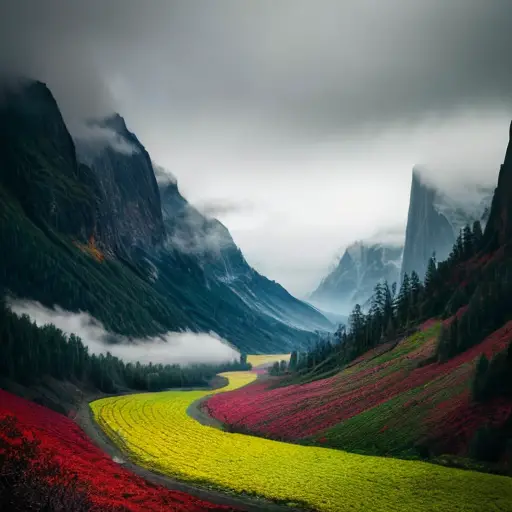Alright, fellow aspiring artists, let's dive into the wonderful world of watercolor painting! Now, I know what you're thinking – watercolors can be a bit tricky, but fear not! I'm here to spill the secrets on essential techniques for beginners. First things first, embrace the magic of wet-on-wet painting. Just like a dance between your brush and the paper, let the colors blend and mingle freely. Next up, don't be afraid to experiment with different brush strokes – from delicate washes to bold splatters, let your creativity flow like a river. And remember, patience is key! Allow those layers to dry before adding more depth and detail. So, grab your brushes, unleash your imagination, and let the watercolors work their enchantment on your canvas!
An interesting fact about learning watercolor painting is that it is often recommended to start with a limited color palette. By using only a few colors, beginners can focus on understanding color mixing, value, and composition without feeling overwhelmed. This approach allows artists to gradually expand their color range and develop a deeper understanding of the medium over time.
Welcome, fellow color enthusiasts, to the vibrant world of watercolor painting! Today, we're going to dive deep into the captivating realm of color theory and the art of mixing pigments. Now, don't be intimidated by the color wheel – it's your trusty guide on this colorful journey. Start by understanding the primary colors – red, yellow, and blue – and how they interact to create secondary and tertiary hues. Experiment with different ratios and combinations, like a mad scientist in their laboratory, until you discover the perfect shade. Remember, a little goes a long way, so start with small amounts of pigment and gradually build up. So, grab your palette, unleash your inner color wizard, and let the watercolors dance harmoniously on your canvas!

Attention, aspiring watercolor maestros! Today, we embark on a quest to master the art of composition and brushwork in this captivating medium. Composition is like the backbone of a painting, so let's start by understanding the rule of thirds. Imagine your canvas divided into a tic-tac-toe grid, and place your focal point at one of the intersecting points. This will create a dynamic and visually pleasing composition. Now, let's talk brushwork. Embrace the versatility of your brushes – from broad wash brushes to fine detail brushes, each stroke adds character to your masterpiece. Experiment with different techniques, like dry brushing for texture or wet-on-wet for soft, dreamy effects. Remember, practice makes perfect, so keep exploring and refining your brushwork skills.
As we delve deeper into the world of watercolor, let's not forget the importance of negative space. Don't be afraid to leave areas of your paper untouched, allowing the white to shine through and create a sense of balance and harmony. Additionally, consider the concept of value – the range of lightness and darkness in your painting. Play with contrast to add depth and dimension, using darker tones to make your focal point pop. Remember, watercolor is all about embracing happy accidents, so don't be afraid to let the paint flow and blend organically.
Now, let's talk about the power of color temperature. Warm colors, like reds and yellows, evoke energy and excitement, while cool colors, such as blues and greens, create a sense of calm and tranquility. Experiment with the interplay of warm and cool tones to evoke different moods in your paintings. And don't forget about color harmony – choose a limited palette of colors that work well together, creating a cohesive and visually pleasing composition.
In the world of watercolor, the magic lies in the delicate balance between control and spontaneity. Embrace the unpredictable nature of the medium, allowing the water and pigments to dance on your paper. Remember, there are no mistakes in watercolor, only happy accidents waiting to be discovered. So, grab your brushes, unleash your creativity, and let the composition and brushwork guide you on a mesmerizing watercolor journey!
A fun fact about learning watercolor painting is that it's like a magical dance between water and pigment! The more water you add to your paint, the lighter and more transparent it becomes. On the other hand, if you use less water, your colors will appear more vibrant and intense. So, by mastering the art of balancing water and pigment, you can create beautiful and captivating watercolor paintings!
Congratulations, adventurous artists! You've mastered the basics of watercolor painting, and now it's time to push the boundaries and explore advanced techniques and experimental approaches. Let's dive into the world of glazing, where transparent layers of color are built up to create luminosity and depth. Embrace the magic of lifting, where you can remove pigment from your paper to create highlights and textures. And don't forget about masking fluid – a handy tool that allows you to preserve areas of white and paint freely without worrying about staying within the lines. Now, let your imagination run wild and experiment with unconventional tools and materials. From salt and alcohol to sponges and plastic wrap, the possibilities are endless. Remember, the beauty of watercolor lies in its versatility and the freedom to explore new horizons. So, grab your brushes, embrace the unknown, and let your creativity soar to new heights in the world of advanced watercolor techniques!